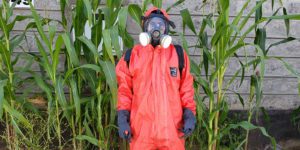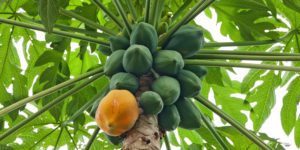Downy mildew is a potentially devastating disease of cucurbit crops which is caused by the fungus-like water mould Pseudoperonospora cubensis. Once established in a region, the disease can spread rapidly, causing significant loss of fruit quality and yield.
It infects squash, pumpkins, melons, gourds, and cucumber, with cucumbers being the most susceptible crop to this pathogen.
The downy mildew pathogen majorly infects the leaves, resulting in decreased photosynthesis, and during favourable environmental conditions it can defoliate plants and destroy entire fields within a short time.
The fruits of infected plants are usually undersized and misshapen. They are also more likely to develop sun scald, which further reduces their quality.
BIOLOGY
Ps. cubensis is an obligate biotroph, i.e., it cannot live long without a host plant. It is favoured by cool, wet and humid conditions and produces microscopic sac-like structures called sporangia over a wide range of temperature (5-30 0C) which act similar to spores. These sporangia are easily transferred to healthy plant tissue by air currents or splashing rain.
Once these sporangia land on a susceptible host, they germinate and can directly infect the leaf within one hour. During prolonged cool wet periods, the sporangia can also burst open and release many zoospores which swim through the film of water along the leaf surfaces towards the stomata. These natural pores are a primary point of entry for the pathogen, resulting in multiple infections on the leaf.
Infection may progress slowly or stop temporarily when temperatures rise above 30°C during the day. Nighttime temperatures of 12°C-25°C promote disease development, especially when accompanied by heavy dews, fog or precipitation. With nighttime temperatures around 15°C and daytime temperatures around 25°C, downy mildew infections on cucurbits produce more sporangia within 4 days.
SYMPTOMS
Initially, symptoms appear as small yellow spots or water-soaked lesions on the topside of older leaves. The centre of the lesion eventually turns tan or brown and dies while the yellow spots sometimes take on a “greasy” appearance and do not have a distinct border.
In cucumbers, the lesions are often confined by leaf veins and appear angular in shape, in cantaloupes they appear irregular in shape, whereas the lesions are smaller and rounder on infected watermelon leaves. Affected tissues in pumpkin can be more orange than yellow.
As the disease progresses, the lesions expand and multiply, causing the field to take on a brown and “crispy” appearance.
Under humid conditions, the lesions often develop a downy growth on the underside of the light yellow lesions observed on the top of the leaf, which is particularly noticeable in the mornings after a period of wet weather or when conditions favour dew formation. The downy growth on the underside of the lesions is frequently speckled with dark purple to black sporangia (spore sacks) and its presence is a key to diagnosing this disease.
The lesions are sometimes invaded by secondary pathogens such as soft rot bacteria or other fungi.
Note that downy mildew lesions usually do not enlarge beyond major veins, giving spots an angular appearance.
MANAGEMENT
Due to the rapid spread of the downy mildew disease and because symptoms often do not appear until 4-12 days after infection, a successful disease management program must be implemented prior to the appearance of the disease symptoms.
The management approaches are as follows;
Chemical method
Systemic and translaminar fungicides with active ingredients that target oomycete fungi are recommended when downy mildew is forecast to occur in an area or symptoms have just started to develop. Application should be done every 5-7 days depending on disease severity.
Fungicide resistance is a concern with downy mildew pathogen and therefore, different fungicides should be alternated.
The following fungicides are used against downy mildew of cucurbits;
- CADILAC 800WP 50g/20l (for prevention purposes)
- FORTRESS GOLD 720WP 40g/20l
- GEARLOCK TURBO 250WP 25g/20l
- KATERINA 720SC 50ml/20l
- PROPELLER 722SL 50ml/20l
- SACRIFIDO 125EC 20ml/20l
- TOWER 720WP 50g/20l
- TRINITY GOLD 452WP 50g/20l
- COMRADE 450SC 20ml/20l
- PYRAMID 700WP 50g/20l
- ABSOLUTE 375SC 10ml/20l
Non-chemical approaches
- Plant resistant varieties.
- When planting cucurbit transplants, ensure that the transplants are free from disease.
- Select fields and manage the crop to promote air movement and reduce humidity levels inside the crop canopy.
- Avoid excess overhead irrigation. Consider irrigating during the late morning to facilitate rapid leaf drying. If possible, use trickle/drip irrigation.
- Maintain good weed control in the field. Control alternate weed hosts, e.g. wild cucumber, and volunteer cucumbers in neighbouring fence rows and field edges.
- Consider washing equipment and tools before moving from one field to another.
- Inspect crops for symptoms weekly.
- If possible, work in diseased fields at the end of the day.
- Monitor disease occurrence and weather forecasts.
- Choose planting sites with good air movement and without shading.
- Avoid overhead irrigation in early morning when leaves are wet from dew or late in the day when leaves will not have an opportunity to dry before dew forms.
- Maintain ample but not excessive nitrogen fertility.
- Remove and dispose infected plants. Do not compost them.
- Practise rotations with non-host crops
Tips!
- Always mix the fungicide with INTEGRA 3ml/20l, which improves the efficacy of the fungicide by acting as a sticker, spreader and penetrant.
- Timely control of the disease is important as it prevents/reduces the losses attributed to the disease infection.
- Ensure a proper nutrition for an improved crop immunity.






